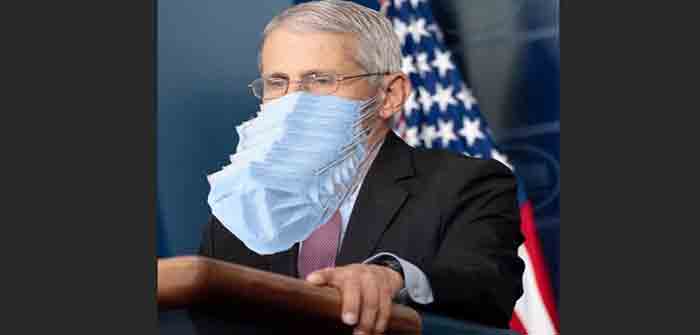
by Scott Morefield at Townhall
Most people probably think of epidemiologists as simply doctors who specialize in contagious illness, but that would be only part of the story. Indeed, rather than studying and finding cures for diseases, arguably the most important component of the field is increasingly being viewed as something else entirely – the molding of public behavior. This explains why so many who go into epidemiology hold undergraduate degrees in public health, which focuses on the social and behavioral sciences, instead of the more hard-core sciency stuff studied by their medical doctor peers, like biology or biochemistry.
So when epidemiologists like Dr. Anthony Fauci make pronouncements from on-high, one must always be aware of the motive behind their messaging – to get YOU to do what THEY tell you to do, purportedly in an effort to “stop the spread” of whatever contagion they are fighting. Except, if you do a deep dive into the nature of most of the world’s response to today’s particular disease du jour, COVID-19, you’ll see that little of it ever had to do with actual science or data. Instead, the bulk of it has focused on implementing and forcing the public to comply with certain non-pharmaceutical interventions (NPIs), like lockdowns and masking, settled upon early on in the pandemic.
While discussing his epic bestseller “Faucian Bargain: The Most Powerful and Dangerous Bureaucrat in American History” with Fox News host Tucker Carlson, radio host Steve Deace described perhaps the most critical 11 days in recent U.S. history:
Citing the known case and infection fatality rates – at around 1.8 percent and .18 percent respectively – Deace described Fauci’s “original cautious and modest expectations” as having turned out to be true. “So why did he abandon those for the fear porn we’ve seen the past year?” he asked. “We must get answers to questions like that … What changed those 11 days, because it changed the fate of America.”
At one point during those 11 days, on March 8, Fauci also gave his now-infamous interview to “60 Minutes” in which he declared that the general public should not “be walking around with a mask.” The next month, of course, the CDC did a complete 180-degree reversal, and Fauci later attributed his earlier stand, which was based on sound science and is still provably correct a year later, to a ‘noble lie’ of sorts, that he was merely saving PPE for healthcare workers. Riiight. As if there wasn’t enough T-shirt material, bandanas, and neck gaiters to go around, or something. The ‘good’ doctor also hilariously claimed that the possibility of asymptomatic spread wasn’t “clear” in March, even though the news-following public, including myself, was well aware of the claim as early as January 2020.
“And for the others around you, it’s a warning. ‘It says: Watch out. There’s a public health crisis right now, there’s a virus going around, we need to be on top guard,’ says [Dr. Michael] Klompas. “I think it can actually be a reinforcer, a reminder of the state of crisis that we face in society.”
Another example comes from this May Health Affairs article about mask use during the 1918 Spanish flu pandemic: “The lessons from the 1918 influenza epidemic for local, state, and federal health officials are clear: Masks must be constructed and worn correctly, wearing masks in public must be part of a comprehensive social distancing strategy, masks are essential for certain care-taking occupations, and the psychological benefits of seeing everyone wearing masks helps raise awareness about disease transmission.”
By May and most certainly June and beyond, masks had become a tool for compliance, a totem to help ‘force’ the public to stay afraid and do the things the medical establishment felt would fight the spread of the pandemic. To them, it likely mattered little to nothing whether the masks actually did anything in and of themselves to accomplish this. Sure, they seized on some bogus one-off hairdresser ‘study’ and some perceived, cherry-picked correlation in Kansas counties to give a sciency tint to the madness, but the strategy after that was obviously to press on and ignore or dismiss any data to the contrary. Suddenly, in the span of a few weeks, decades of science was tossed aside and “masks work!” became ‘settled science’ that wasn’t to be questioned.
This could explain much of the mixed messaging given over time by the CDC and WHO. In June, when a WHO official said the much-ballyhooed asymptomatic virus spread was “very rare,” she was quickly made to backtrack and withdraw her statement. I submit that this wasn’t because she was inaccurate, but because the powers-that-be quickly perceived that this information would be a severe blow to those who wanted widespread forced public masking to continue.
More recently, the CDC can’t get its own messaging straight. Should vaccinated people travel or should they not? Can they transmit the virus? Hints and statements that they can’t are quickly suppressed, and my guess, again, is that the shuffling here has far more to do with their cult-like devotion to masks than anything else. If vaccinated people can travel and aren’t transmitting, why should they continue to wear masks? The only conceivable answer is that none of this has ever been about science, only behavior modification.
Viewing it through this lens, you can see the drama play out in stunning detail in the exchanges last month between Sen. Rand Paul, who aptly pointed out the “viral theater” of requiring the vaccinated to continue to mask up, and Fauci, who gets visibly frustrated and increasingly illogical trying to keep the lid on the deception. Weeks later, when asked by MSNBC why states that have lifted mask mandates, like Texas and Mississippi, aren’t spiking like New York, Michigan, and other places, Fauci admits, “I’m not really quite sure.”
Indeed, from the ridiculous ‘masked walk of shame’ from the doors of a restaurant…
Continue Reading